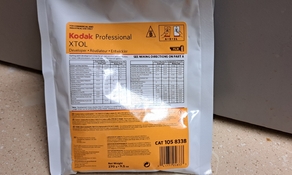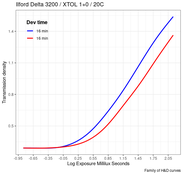I finally got around to developing KODAK T-MAX P3200 and Ilford Delta 3200 in XTOL. I wanted to see how the films would respond to being pushed, i.e., to being underexposed and overdeveloped. I exposed each film for 1 EV and 2 EV less exposure than in my previous test. This would be roughly equivalent to being exposed at ISO 1600 and ISO 3200. I developed in XTOL stock (unseasond) for 16 minutes at 20C in a rotary processor (following KODAK's recommendation). The results surprised me.
First of all, XTOL, with the T-MAX P3200, produces very different curves than it does with D-76 . In fact, based on my tests so far, I would recommend ditching D-76. The XTOL curves are much better formed. That lumpiness I mentioned earlier? Gone! I was really surprised by this. XTOL produces nearly linear curves, except the long toe, of course. As far as Ilford Delta 3200, XTOL also produces slightly better formed curves, but the result is not nearly as pronounced because they were already very linear with D76. The ISO 1600 curves are in red, and the ISP 3200 are in blue.
How about film speed? So far, I have found XTOL to not produce significantly greater film speed in this test. However, this is just one test. I will repeat the test, and once my XTOL is seasoned, I will repeat it yet again.
Contrast Index (CI) is very well-controlled with XTOL, ranging from, roughly, 0.65 to 0.75. I guess this is what people mean when they say these ISO 3200 films have inherently low contrast. With XTOL, they do seem to.
So does XTOL have magic? I would say, with T-MAX P3200, there's some magic to it. Yes.
Now I am really curious how seasoned XTOL will perform.
View attachment 322757View attachment 322759






